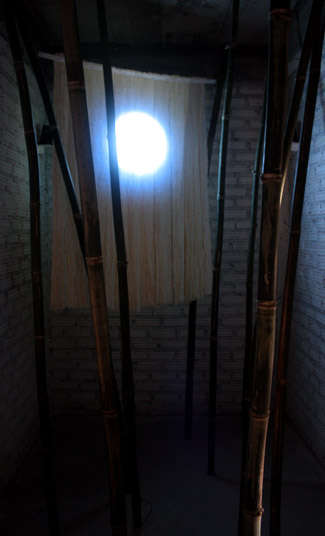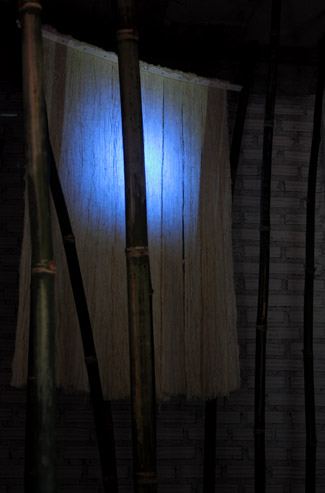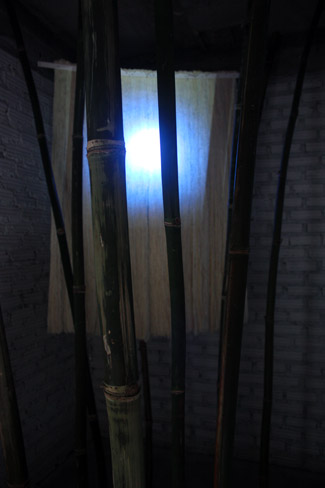10 minute audio-visual recording of ‘multitudinous entity’, four channels converted into stereo |
|
‘multitudinous entity’ is a generative audio visual work, based in its progression, on the pattern generated by the interplay of multiple autonomous agents simulating swarm behaviour. Its aesthetic qualities are derived from the properties of the Japanese shakuhachi flute; an instrument closely linked to the tradition of Zen philosophy. |
The term ‘super organism’ is used in scientific theory for large formations of animals such as swarms, flocks or herds seemingly acting in unison, without central control. Michael Ende beautifully depicts this idea in his book The Never Ending Story. His creature Ygramul, or The Many is a shapeshifter, composed of a huge number of hornet-like insects, sharing a single mind.
|

|
While Ende’s depiction of Ygramul is fantastical, research into the behaviour of large animal formations has attributed ‘swarm intelligence’ to this phenomena. The ability of ‘super organisms’ to organises and perform comparatively complex tasks thereby exceeds the capacity of each individual member. The seemingly unanimous activity of certain insects, birds, fish or mammals, congregating in large numbers is explained by sets of simple predetermined rules guiding the interaction between its individual members and their immediate neighbours. No individual thus has awareness or control of the collective activity, but only responds to stimulus from its nearest surrounding. The ‘intelligence’ of the whole arises purely based on the multiple repetitions of individual simultaneous interaction. This means, a simple set of rules governing the interaction of a large number of individuals can give rise to great complexity.
The deployment of this concept is used in ‘multitudinous entity’ as a control mechanism for all variables in this audio/visual work. A simplified model of swarm behaviour (a swarm generator with eleven individual entities) acts as the ‘improvising performer’. The collective movement of these entities, in the two
|
dimensional space of a coordinate system, thus is predominantly governed by the interaction of each entity with its three closest neighbours. This ever-changing constellation differs from random behaviour by displaying certain characteristics in its ever-changing movement. |
The aim in using this particular mathematical modelling is to recreate the infinite ability of natural systems to repeat the same action without ever replicating it; to evoke the fractal concept of infinity contained within a finite space. |
|
Swarm generator controlling ‘multitudinous entity’ (5 minute recording). |
The pairing of this mathematical modelling of nature with aesthetic and musical characteristics of the shakuhachi flute derives from the intrinsic appreciation of the natural process inherent in Zen philosophy. The refined development of the instrument and its complex playing techniques, as well as its musical repertoire, thus reflect an acoustic embodiment of Zen’s aesthetic values.
|

|
Made from the root end of bamboo, the flute has an exceptional ability to produce a wide range of sound. Starting with a quiet breath or wind sounds to the clearest of pitch, a skilled player is capable of soft gradual variation as well as fast changes. The unique natural fluidity of its sound is based on this ability to control the timbre of the sound within a single note, and the seamless manipulation of its pitch. Tuned to a pentatonic scale (5-notes within the octave), and only 5 holes, the flute has no limits in its pitch within the confines of the two full and partial third octave of its range. Deviations from its basic pentatonic structure can be achieved through a variety of fingering and blowing techniques. The choice in techniques to achieve a given pitch thus extends the repertoire of timbre. In addition to this, the played note can be bend upwards or downwards, to the extent of a whole tone, by adjusting the blowing angle.
Based on this unusual flexibility to manipulate the quality of each played note, shakuhachi music is often slow and drawn, with a strong emphasis on the subtlety of change. Importance is placed on the framing of notes, or short sequences, in |
silence, and the subsequent swelling of a single note from and to the same. The rise and fall of sound thereby is it’s rhythmic structure, obedient only to the flow of the music. Like most other aesthetic aspects of Zen, the close observation of nature gives rise to the aspiration of reflecting its subtle beauty into the realm of art.
|

|
Installed at '3rd Space' a Surface Arts Project, 2013, (projection screen made from unspun silk, 110 x 140 cm and green bamboo) H-Gallery, Chiang Mai, Thailand |
|